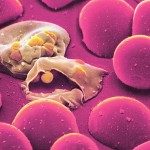Link to Pubmed [PMID] – 26001482
Link to DOI – 10.1016/j.pt.2015.04.010S1471-4922(15)00092-6
Trends Parasitol 2015 Aug; 31(8): 357-62
Malaria parasites undergo a complex life cycle between their hosts and vectors. During this cycle the parasites invade different types of cells, migrate across barriers, and transfer from one host to another. Recent literature hints at a misunderstanding of the difference between active, parasite-driven migration and passive, circulation-driven movement of the parasite or parasite-infected cells in the various bodily fluids of mosquito and mammalian hosts. Because both active migration and passive transport could be targeted in different ways to interfere with the parasite, a distinction between the two ways the parasite uses to get from one location to another is essential. We discuss the two types of motion needed for parasite dissemination and elaborate on how they could be targeted by future vaccines or drugs.

